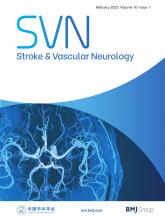Abstract
Objective Various risk scoring models have been developed to predict stroke-associated pneumonia (SAP). We aim to determine whether these risk models could effectively predict SAP in Chinese patients with ischaemic stroke (IS).
Methods Consecutive patients with IS in West China hospital between January 2011 and September 2013 were included to assess the predictive performance of risk scoring models, including Chumbler's score, A2DS2 and AISAPS. The area under the receiver operating characteristic curve (AUROC) was used to evaluate the performance of each risk model in predicting pneumonia.
Results A total of 1569 consecutive patients with IS within 30 days of onset in West China hospital were included. The incidence of pneumonia is 15.3%. The AUROC of Chumbler's score, A2DS2 and AISAPS was 0.659, 0.728 and 0.758, respectively, and AISAPS had the highest AUROC.
Conclusions A2DS2 and AISAPS had acceptable discriminatory abilities to predict SAP in Chinese patients with IS within 30 days of onset.
Footnotes
SG and ZZ made equal contributions to the study and the article.
Contributors SG and ZZ drafted the manuscript. ZL and NC retrieved the data. JG and MZ performed the statistical analysis. LH critically revised the manuscript.
Competing interests None declared.
Provenance and peer review Not commissioned; externally peer reviewed.
Data sharing statement No additional data are available.
This is an Open Access article distributed in accordance with the Creative Commons Attribution Non Commercial (CC BY-NC 4.0) license, which permits others to distribute, remix, adapt, build upon this work non-commercially, and license their derivative works on different terms, provided the original work is properly cited and the use is non-commercial. See: http://creativecommons.org/licenses/by-nc/4.0/






